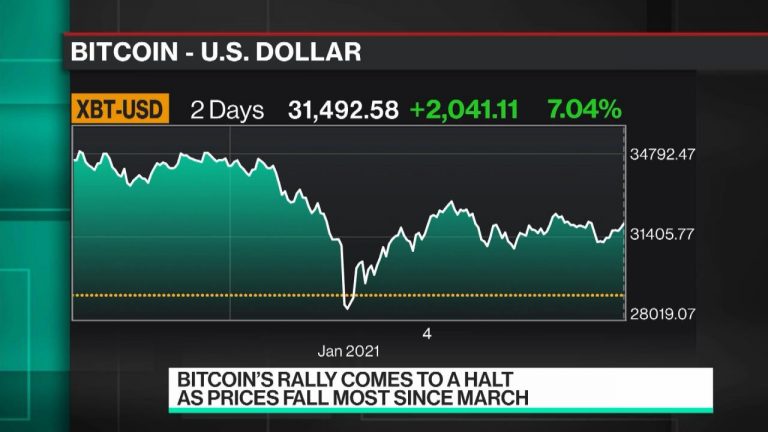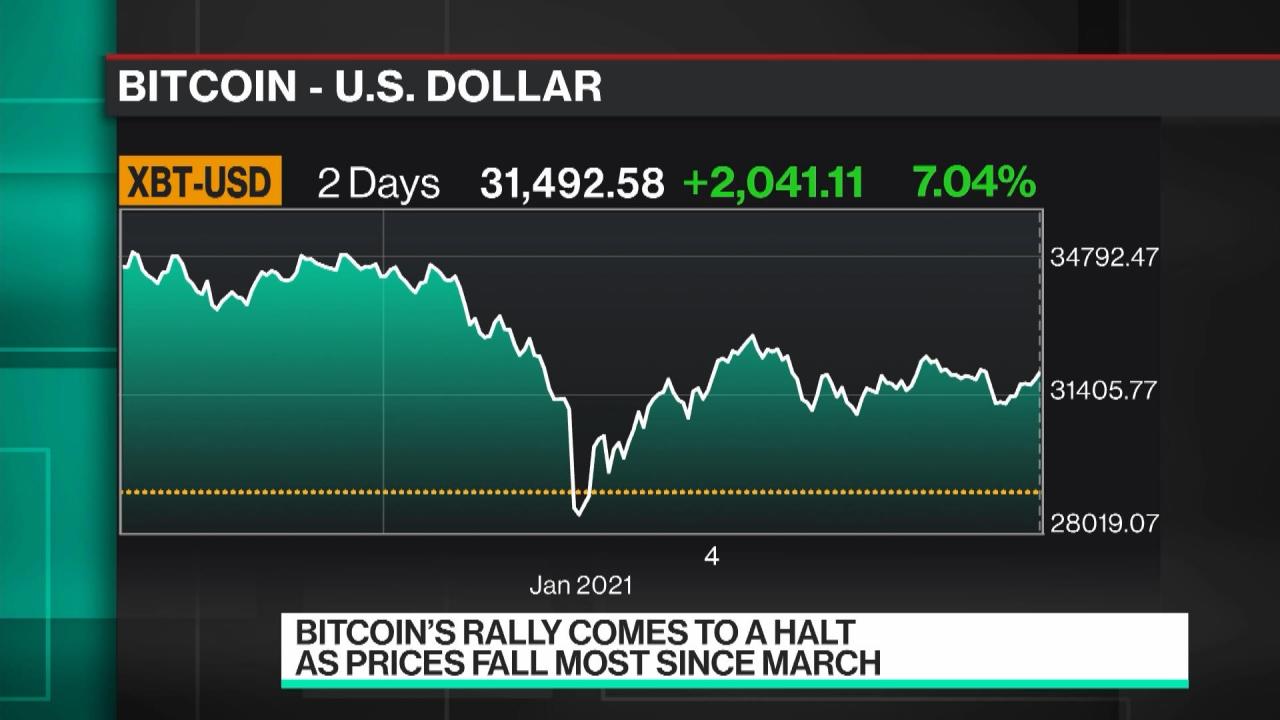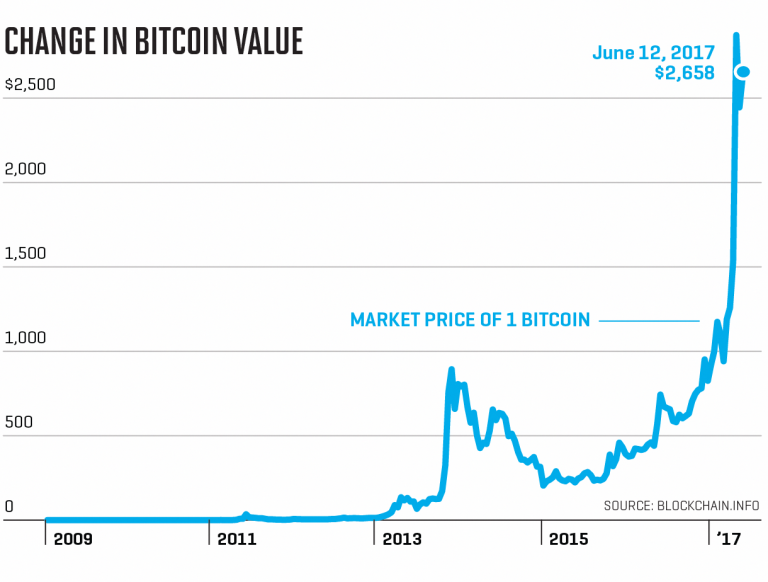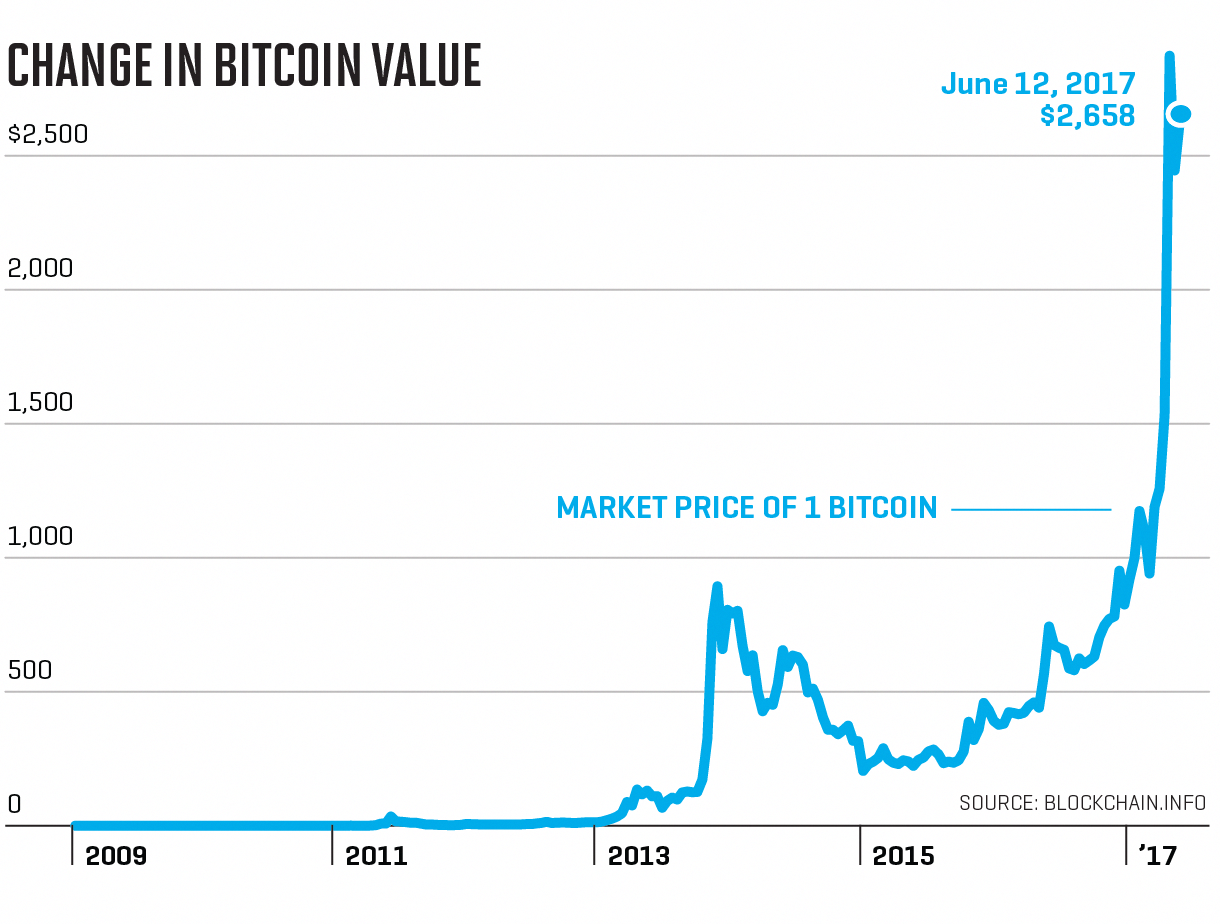Bitcoin price chart is a fascinating window into the world of cryptocurrency trading, offering insights into past performance and future potential. As the most prominent digital currency, understanding its price movements through charts can help both novice and seasoned investors make informed decisions.
This exploration delves into key components of bitcoin price charts, from time frames and price indicators to candlestick patterns and significant historical trends, equipping you with the essential tools to navigate the evolving landscape of bitcoin investing.
Understanding Bitcoin Price Charts
Bitcoin price charts are essential tools for traders and investors, offering insights into market trends and helping predict future movements. These charts represent the historical price performance of Bitcoin over various time frames, allowing users to analyze price action and make informed trading decisions. Understanding the various components of these charts is crucial for anyone looking to engage with the cryptocurrency markets effectively.The primary components of a Bitcoin price chart include time frames, price indicators, and volume analysis.
Time frames can vary from seconds to years, with shorter time frames suitable for day traders and longer ones preferred by investors looking at the bigger picture. Price indicators, such as moving averages, Relative Strength Index (RSI), and Bollinger Bands, help identify trends and potential reversal points. Volume analysis indicates the strength behind price movements, with higher volumes often suggesting more significant changes.
Components of Bitcoin Price Charts
Several elements make up a Bitcoin price chart, each serving a distinct purpose in the analysis. Understanding these components is vital for effective trading strategies.
- Time Frames: Bitcoin charts can be viewed in various time frames, including 1-minute, 5-minute, hourly, daily, weekly, and monthly intervals. Each timeframe provides different insights—shorter timeframes allow for quick trades, while longer ones highlight overarching trends.
- Price Indicators:
–
Moving Averages (MA):
These are calculated by averaging the price over a specific period, smoothing out fluctuations to identify trends.
–
Relative Strength Index (RSI):
This momentum oscillator measures the speed and change of price movements, indicating overbought or oversold conditions.
–
Bollinger Bands:
These consist of a middle band (simple moving average) and two outer bands that indicate volatility, helping traders recognize potential buy and sell signals.
- Volume: This represents the total number of coins traded over a specific period. High volume often supports price movements, while low volume can indicate a lack of conviction in the trend.
Price Trends and Patterns in Bitcoin Charts
Identifying price trends and patterns is fundamental to Bitcoin trading, as they often signify future price movements. Trends can be classified as upward (bullish), downward (bearish), or sideways (neutral). Recognizing the direction of the trend allows traders to align their strategies accordingly.Common patterns observed in Bitcoin charts include head and shoulders, double tops and bottoms, and flags. Each of these patterns has specific characteristics that traders look for:
- Head and Shoulders: This pattern indicates a reversal in trend, often occurring at market tops. It consists of three peaks—one higher peak (the head) between two lower peaks (the shoulders).
- Double Tops and Bottoms: A double top signals a bearish reversal and is characterized by two peaks at approximately the same price level. Conversely, a double bottom suggests a bullish reversal, marked by two troughs at similar levels.
- Flags: These are continuation patterns that appear after a strong price movement. Flags are typically short-term consolidations that indicate a potential breakout in the direction of the previous trend.
Common Chart Types Used in Bitcoin Trading
Various chart types are utilized in Bitcoin trading, each presenting data differently and catering to diverse analytical preferences. Understanding these chart types is critical for traders seeking to implement effective strategies.
- Candlestick Charts: These charts display the open, high, low, and close prices within a specific time frame, offering detailed insights into price movements. Each candlestick represents a particular time period and provides a visual representation of market sentiment.
- Line Charts: A simpler representation, line charts connect closing prices over a specific period, making it easier to identify overall trends without the noise of daily price fluctuations.
- Bar Charts: Similar to candlestick charts, bar charts show the open, high, low, and close prices for a specific time period. They provide a comprehensive overview of price movements while being less visually detailed than candlesticks.
Understanding these components, trends, and chart types lays a solid foundation for analyzing Bitcoin price movements and making informed trading decisions. The intricate dynamics of Bitcoin price charts reveal crucial insights that can significantly influence trading strategies and outcomes.
Reading Bitcoin Price Charts
Understanding how to read Bitcoin price charts is essential for traders and investors. These charts provide vital information about market movements, trends, and potential future price actions. By interpreting the data presented in these charts, one can make informed decisions on buying or selling Bitcoin.Candlestick patterns are a fundamental aspect of reading Bitcoin price charts. Each candlestick represents a specific time frame, showing the open, high, low, and close prices.
Understanding these patterns can provide insights into market sentiment and potential reversals.
Candlestick Patterns
Candlestick patterns are crucial for predicting future price movements. These patterns can indicate bullish or bearish trends based on the shape and size of the candlesticks. Some common patterns include:
- Doji: Represents indecision in the market, often signaling a potential reversal.
- Hammer: A bullish reversal signal, typically found at the bottom of a downtrend.
- Engulfing Pattern: A strong reversal signal where a small candle is followed by a larger candle that engulfs it.
It’s important to consider the context of these patterns and their location on the chart for accurate interpretations.
Support and Resistance Levels
Identifying key support and resistance levels on a Bitcoin price chart is critical for understanding market behavior. Support levels are price points where buying interest is strong enough to overcome selling pressure, while resistance levels are where selling interest is strong enough to overcome buying pressure.To identify these levels, traders often look at:
- Previous highs and lows: Historical price points can serve as strong indicators of future support or resistance.
- Fibonacci retracement levels: These levels help predict potential reversal points based on the Fibonacci sequence.
- Trend lines: Drawing trend lines connecting previous highs or lows can highlight potential support and resistance areas.
Recognizing these levels helps traders make educated decisions about entry and exit points.
Volume Indicators
Volume indicators are essential for confirming price movements. They indicate the number of assets traded over a specific time frame, providing insights into the strength of price movements. High volume during price increases suggests strong buying interest, while high volume during price decreases suggests strong selling interest.Key techniques for interpreting volume alongside price movements include:
- Volume Spikes: A sudden increase in volume can indicate a significant price movement is likely to follow.
- Volume Divergence: When price moves in one direction but volume moves in the opposite direction, it can signal a potential reversal.
- Volume Moving Averages: Analyzing moving averages of volume can help smooth out spikes and identify underlying trends.
Incorporating volume analysis with price movements enhances the accuracy of trading decisions, providing deeper insights into market dynamics.
Historical Bitcoin Price Trends
The historical price movements of Bitcoin showcase its volatility and its journey from a niche digital asset to a mainstream financial instrument. Over the last decade, Bitcoin has experienced significant price fluctuations influenced by a variety of events, market sentiments, and regulatory developments. Understanding these trends is crucial for anyone looking to engage with Bitcoin on a deeper level.The price of Bitcoin has seen explosive growth since its inception, shaped by various factors including technological advancements, macroeconomic conditions, and investor sentiment.
Below, we explore a timeline of key events that have significantly impacted Bitcoin’s price trajectory.
Timeline of Major Events Influencing Bitcoin Prices
The following timeline highlights significant occurrences that have shaped Bitcoin’s market value over the years. Each event played a pivotal role in either driving prices up or contributing to downturns.
- 2011: Bitcoin reaches $1 for the first time, marking its entry into the mainstream.
- 2013: The price skyrockets to over $1,000, fueled by increasing media coverage and adoption.
- 2014: The collapse of Mt. Gox, a major Bitcoin exchange, leads to a significant price drop, closing the year at around $300.
- 2017: Bitcoin experiences a massive rally, peaking near $20,000 in December, driven by increased institutional interest and speculation.
- 2018: A bear market ensues, with the price falling to around $3,200 by the end of the year due to regulatory scrutiny and market corrections.
- 2020: Amid the COVID-19 pandemic and economic uncertainty, Bitcoin begins to rise again, ending the year above $28,000.
- 2021: The price of Bitcoin reaches an all-time high of approximately $64,000 in April, spurred by institutional investments and growing acceptance.
- 2022: The crash of crypto markets and tightening monetary policy leads to a decline, with Bitcoin falling back toward the $20,000 mark by the end of the year.
- 2023: As of October 2023, Bitcoin shows signs of recovery and fluctuates around the $30,000 mark, amid ongoing developments in regulation and technology.
Comparison of Bitcoin Price Behavior During Bull and Bear Markets
Understanding the contrasting behaviors of Bitcoin during bull and bear markets is essential for assessing investment strategies. The following table illustrates the price behaviors during these two market conditions over the last decade.
| Market Type |
Key Characteristics |
Price Movements |
Investor Sentiment |
| Bull Market |
Rapid price increases, high trading volumes, positive news coverage |
2013: $13 to $1,000, 2017: $1,000 to $20,000 |
Optimistic, speculative, increased media attention |
| Bear Market |
Declining prices, reduced trading volumes, negative media coverage |
2014: $1,000 to $300, 2018: $20,000 to $3,200 |
Pessimistic, cautious, media focus on failures |
Understanding historical trends is essential for making informed decisions in the volatile world of Bitcoin trading.
Tools for Analyzing Bitcoin Price Charts
Analyzing Bitcoin price charts requires the right set of tools to make informed decisions. Various platforms and software are available that provide comprehensive features for traders and analysts alike. With the right tools, you can gain insights into market trends, price movements, and potential future actions.When selecting a tool for analyzing Bitcoin price charts, it’s crucial to consider not only the user interface but also the range of features that can enhance your analytical capabilities.
The following table summarizes some popular tools and their features.
Popular Software and Platforms
The following table Artikels several tools that are widely used for analyzing Bitcoin price charts, highlighting their features and advantages.
| Tool |
Features |
Advantages |
| TradingView |
Customizable charts, social trading features, various technical indicators |
Intuitive interface, large community for sharing ideas, excellent for both beginners and seasoned traders |
| Coinigy |
Multi-exchange trading, advanced charting tools, alerts |
Allows trading across various exchanges from one platform, comprehensive market data |
| MetaTrader 4/5 |
Automated trading, backtesting capabilities, extensive indicators |
Robust trading options for advanced users, widely recognized and trusted in the trading community |
| Cryptowatch |
Real-time data, portfolio tracking, multiple exchange support |
User-friendly interface, allows for detailed market analysis at a glance |
| CoinMarketCap |
Market capitalization data, historical price charts, market news |
Great for getting a quick overview of market trends, reputable source of cryptocurrency data |
Effective use of technical indicators can significantly enhance your analysis of Bitcoin price charts. Here are some tips for utilizing these indicators efficiently:
Combine Indicators
Use a mix of indicators to confirm trends; for example, combining Relative Strength Index (RSI) with Moving Averages can provide a more accurate picture of potential market movements.
Understand Market Context
Always consider the broader market context when applying indicators. An indicator may signal a buy in isolation, but market sentiment could suggest caution.
Set Alerts
Most platforms allow you to set alerts for specific price levels or indicator thresholds, helping you stay informed without constant monitoring.
Backtesting
Utilize historical data to test the effectiveness of your chosen indicators before applying them in live trading scenarios.
Regular Review
Frequently review your strategies and the effectiveness of your indicators based on changing market conditions, adapting as necessary for optimal performance.By leveraging these tools and techniques, traders can enhance their analysis of Bitcoin price charts, enabling more informed trading decisions.
Impact of External Factors on Bitcoin Prices
The price of Bitcoin does not exist in a vacuum; it is significantly influenced by various external factors ranging from macroeconomic trends to regulatory changes. Understanding these influences can provide investors with better insights into the market dynamics and help them make informed decisions.Macroeconomic factors such as inflation rates, interest rates, and overall economic stability can have profound effects on Bitcoin price trends.
When traditional fiat currencies are weakened by inflation, investors often turn to Bitcoin as a hedge against currency devaluation. Furthermore, in times of economic uncertainty, the demand for alternative assets, including cryptocurrencies, tends to rise, which can increase Bitcoin’s price.
Effect of Regulatory News on Price Stability
Regulatory developments play a crucial role in determining Bitcoin’s price stability and overall market confidence. News regarding government regulations or legal frameworks can lead to rapid fluctuations in Bitcoin’s price, impacting investor sentiment and behavior.Positive regulatory news, such as the approval of Bitcoin-related financial products or clearer legal frameworks, can bolster confidence and drive prices up. In contrast, negative news—such as potential bans on cryptocurrency trading or strict regulations—can lead to sharp declines in price.
Here are some key aspects of how regulatory news influences Bitcoin:
- Regulatory clarity can attract institutional investment, enhancing market liquidity and stability.
- Strict regulations may lead to market volatility, causing panic selling among retail investors.
- The announcement of regulatory enforcement actions can trigger significant price drops due to fear of increased scrutiny.
- Geopolitical tensions resulting in regulatory changes can lead to speculative trading patterns, impacting price stability.
Correlation Between Bitcoin Prices and Traditional Financial Markets
The relationship between Bitcoin and traditional financial markets, such as stocks and commodities, has garnered significant attention. Understanding this correlation can provide insights into Bitcoin’s behavior during different economic cycles.The following points illustrate the correlation between Bitcoin prices and traditional markets:
- Bitcoin often behaves like a risk-on asset, appreciating during bullish trends in equity markets, and declining during market corrections.
- During economic downturns, Bitcoin may act as a non-correlated asset, attracting investors seeking refuge from traditional market volatility.
- Events such as interest rate changes by central banks can affect Bitcoin prices, especially if they impact investor sentiment toward risk assets.
- Cryptocurrency markets may react to macroeconomic indicators like employment rates and GDP growth, similar to traditional financial markets.
The interplay between these external factors and Bitcoin prices underscores the complex nature of cryptocurrency investments. Investors must pay attention to both global economic indicators and regulatory developments to navigate the volatile landscape of Bitcoin trading effectively.
Forecasting Future Bitcoin Price Movements
Forecasting Bitcoin price movements can seem daunting, but with the right frameworks and methodologies, traders and investors can make informed predictions. By analyzing historical trends, employing technical indicators, and considering external factors, one can develop a robust approach to predicting Bitcoin’s future prices. This section will walk you through essential strategies for forecasting, including a focus on back-testing and the critical role of sentiment analysis.
Framework for Predicting Bitcoin Price Trends
Creating a reliable framework for predicting future Bitcoin price trends involves several key components. Traders can utilize technical analysis, identifying patterns and trends within the price charts. The following elements are instrumental in developing a comprehensive forecasting model:
- Trend Analysis: Identify long-term, medium-term, and short-term trends by examining moving averages, support and resistance levels, and chart patterns.
- Technical Indicators: Use indicators like RSI (Relative Strength Index), MACD (Moving Average Convergence Divergence), and Bollinger Bands to assess market momentum and potential price reversals.
- Volume Analysis: Analyze trading volume alongside price movements to validate trends. Increased volume typically confirms the strength of a price move.
- Chart Patterns: Recognize patterns such as head and shoulders, triangles, and flags that historically indicate future price movements.
Employing these tools allows traders to build a multi-faceted view of potential price movements, improving accuracy in their forecasts.
Back-Testing Price Predictions Using Historical Data
Back-testing is a critical method for verifying the effectiveness of a price prediction model. By utilizing historical Bitcoin data, traders can simulate their forecasting strategies and assess their potential success. The process typically involves:
- Data Collection: Obtain historical price data for Bitcoin, including daily, weekly, or monthly price points depending on the trading strategy.
- Simulation: Apply the developed forecasting model to historical data, predicting prices based on past trends and movements.
- Analysis of Results: Evaluate the accuracy of predictions by comparing forecasted prices to actual historical prices, determining hit rates and profitability.
By systematically testing models against historical data, traders can refine their approaches and improve future predictions.
Importance of Sentiment Analysis in Forecasting Bitcoin Prices
Sentiment analysis has become an increasingly vital aspect of forecasting Bitcoin prices. The cryptocurrency market is heavily influenced by public perception and news events, making it crucial to gauge sentiment. Key factors in sentiment analysis include:
- Social Media Monitoring: Platforms like Twitter and Reddit can provide insights into public sentiment regarding Bitcoin, with spikes in positive or negative sentiment often correlating with price movements.
- Market News: Analyzing news articles and reports can help gauge market sentiment. Positive news, such as institutional adoption, may drive prices up, while regulatory news can lead to declines.
- Sentiment Indicators: Utilize specialized tools and indices such as the Fear and Greed Index to measure market sentiment quantitatively, allowing for data-driven decision-making.
Recognizing the emotional drivers of market behavior provides traders with an additional edge in forecasting Bitcoin price trends, enhancing the overall forecasting framework.
Case Studies of Bitcoin Price Movements
Bitcoin’s price history is marked by several significant spikes and drops that reflect the volatility and dynamics of the cryptocurrency market. These case studies not only highlight the extreme fluctuations in Bitcoin’s value but also provide insights into the factors that drive these movements. Understanding these case studies is essential for any investor or enthusiast looking to grasp the complexities of Bitcoin price trends.Analyzing Bitcoin’s price movements requires a focus on both the major spikes that have occurred and the recovery patterns following sharp declines.
Historical events can offer lessons on market behavior and external influences, helping investors make informed decisions. Below, we delve into notable case studies of Bitcoin price movements, encompassing both dramatic price increases and declines.
Analysis of Significant Price Spikes
Several instances in Bitcoin’s history stand out due to extraordinary price surges driven by various catalysts. Each spike presents unique circumstances, yet they share common underlying themes.
| Date |
Price Spike |
Trigger |
Impact |
| December 2017 |
$19,783 |
Increased media coverage, retail investor interest |
Pushed Bitcoin into mainstream conversation, leading to extensive speculative trading. |
| April 2021 |
$64,863 |
Institutional investment from Tesla, MicroStrategy |
Legitimized Bitcoin as a viable asset class and increased institutional adoption. |
| November 2021 |
$69,000 |
Increased adoption and positive market sentiment |
Peak of the bull market, creating substantial wealth for early investors. |
Aftermath of Sharp Price Drops
Sharp declines in Bitcoin’s price often trigger a cycle of panic selling followed by recovery phases. Understanding how the market reacts post-drop can provide valuable insights into investor psychology and market resilience.
January 2018 Drop
Following the peak in December 2017, Bitcoin’s price dropped to approximately $6,000 by February 2018. This decline was fueled by regulatory scrutiny and the exit of speculative investors.
March 2020 Crash
The COVID-19 pandemic caused a market-wide sell-off in March 2020, bringing Bitcoin’s price down to around $3,800. The subsequent recovery showcased the asset’s resilience, rapidly reaching $10,000 by May 2020.
May 2021 Correction
After reaching an all-time high, Bitcoin’s price fell to $30,000 by June 2021. The market slowly recovered, highlighting a strong support level and renewed investor confidence.
Comparative Analysis of Recovery Patterns
The recovery patterns following price drops can vary significantly based on the context of the decline. Below is a table illustrating the recovery timelines and patterns observed after notable drops.
| Event |
Lowest Price |
Recovery Timeframe |
Characteristics of Recovery |
| January 2018 Drop |
$6,000 |
Over 1 year |
Gradual recovery, influenced by regulatory clarity and market maturity. |
| March 2020 Crash |
$3,800 |
Less than 3 months |
V-shaped recovery; rapid influx of institutional money. |
| May 2021 Correction |
$30,000 |
Approximately 6 months |
Longer recovery, underscored by ongoing debates regarding energy consumption and regulation. |
Concluding Remarks
In summary, mastering the bitcoin price chart not only aids in recognizing market patterns and trends but also enhances your capability to make strategic trading decisions. As the cryptocurrency market continues to grow and evolve, staying informed about bitcoin price movements will be crucial for any investor looking to thrive in this dynamic environment.
FAQ Overview
What is a bitcoin price chart?
A bitcoin price chart visually represents the historical price movements of bitcoin over time, helping traders analyze trends and make predictions.
How can I read a bitcoin price chart?
You can read a bitcoin price chart by understanding key components like time frames, candlestick patterns, and support and resistance levels.
What are the main types of bitcoin charts?
The main types of bitcoin charts include line charts, candlestick charts, and bar charts, each offering unique insights into price behavior.
What factors influence bitcoin prices?
Bitcoin prices are influenced by macroeconomic factors, regulatory changes, market sentiment, and trading volume.
Can I predict future bitcoin prices?
While past performance and technical indicators can provide insights, predicting future bitcoin prices involves uncertainty and should be approached cautiously.



